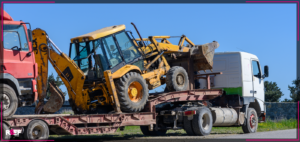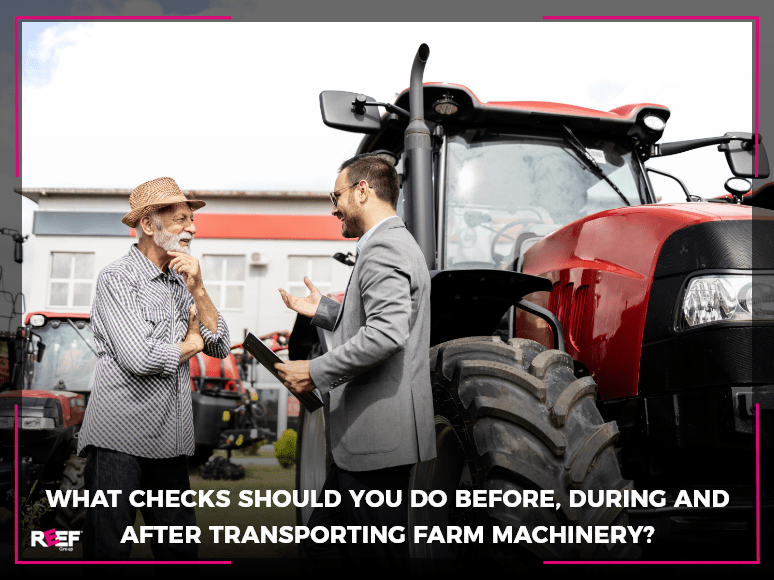Preparing Machinery Before Transport? Here’s What You Need to Know

Choosing the right low loader for your transportation needs
June 10, 2024
Adverse Weather Conditions and Other Challenges in Container Handling
July 4, 2024
Moving heavy machinery from one location to another is necessary from time to time. While the task may seem daunting at first, with the right preparation and expert assistance, the job is made so much easier. Preparation and meticulous planning are key to a smooth, seamless move. It’s also necessary for safety reasons and regulations compliance.
Whether it’s a building site, a farm, or anywhere else where heavy machinery is required, it’s important to understand the steps you need to take in the lead-up to the big move. This article provides a guide on what you need to do and what you need to know.
Obtain necessary permits and documentation
Local, state and federal governments in Australia set size and weight limits for moving heavy machinery, and in some areas, you might be restricted to moving at specified times of the day. All government authorities require you to have permits before the move can take place. This is to ensure everything is legal and that safety regulations are followed.
Firstly, check with your local and state governments regarding what permits are required, and you’ll also need to measure the heavy equipment you’ll be hauling.
Choosing the right shipping method
You need to choose the best shipping method for the type of machinery you’re going to transport.
Shipping container
One option is the shipping container method if the equipment fits inside the container. This is a very safe means of transport as the goods are protected, and the process of loading and unloading the container on and off a truck is straightforward. Not all heavy loads will fit inside a shipping container, though.
Lift-on/lift-off
With this method, a crane is used to lift the heavy machinery onto the back of a truck. Once the load arrives at the other end, a crane is employed to lift the load off the truck, ready for set-up in its new location. The crews at both locations need to be fully trained in this method of transportation, for a smooth loading and unloading process and safe transportation en route.
Roll-on/roll-off
The roll-on/roll-off method applies to heavy machinery with wheels or tracks. An excavator is a good example. A ramp is required to wheel the equipment onto the truck, so you’ll need to factor in the weight of the machinery.
Flat rack
While this is a common shipping method where the machinery travels on a stackable container, its one downside is the equipment is fully exposed to the elements while in transit. Extra precautions are required to avoid damage to the equipment, the transport vehicle and the surroundings.
Preparing the equipment for transport
Let’s now get into the nitty-gritty of what needs to be done to prepare for moving heavy machinery.
Inspections and cleaning
Before your equipment goes anywhere, a thorough inspection must take place by a trained expert. This is to ensure everything has been loaded correctly, is secure, and also to identify any potential issues.
It’s also just as important to thoroughly clean the equipment prior to hauling. When clean, there’s no chance of debris flying off during transit and causing damage to other vehicles and so on.
Disassembling and securing parts
If any items need to be disassembled before shipping, employ someone qualified to carry out the task. It’s a good idea to keep an inventory of the parts and to label them. This will make the reassembly process at the other end much easier. Delicate items should be packaged with protective padding, such as sponge, cloth or even bubble wrap. All disassembled parts should be packed and stowed securely before the equipment is transported.
Fluid and battery management
Disconnect all batteries and other power supplies before transporting. This is essential to ensure no incidents or injuries happen while the machinery is in transit. Fluids should also be drained from the machinery, as they have the potential to become mixed while moving is underway.
Ensuring transport safety
Firstly, check with the equipment manufacturer for effective and safe securement recommendations. Alternatively, this information is often found in the user manual. Not only is it necessary to follow their guidelines for safety reasons and a smooth haul, but ignoring instructions could potentially void any warranty covering the equipment.
Common methods of securement include the use of tie-downs, chains, ropes, straps and other devices.
Route planning and final checks
Always check with local and state government departments first before planning your route to the destination, as you may be restricted to certain times of the day or to using particular roads. Other factors to consider are whether there are any bridges, areas with low clearance (such as an overpass), and areas where high traffic is expected.
All equipment being transported should be thoroughly inspected to guarantee there are no safety concerns. This includes checking the securement points. Next, the vehicle transporting the cargo should also undergo an inspection to determine that everything is in good working order. The transport vehicle needs to be clean and free of debris as well.
Unloading and post-transport procedures
To guarantee everything is safely unloaded at the new location, you’ll want a team of trained experts ready and waiting to perform this task. You’ve carefully planned and prepared for hauling, and the equipment has arrived safe and sound. However, being methodical and doing everything correctly is just as important now as before shipping.
If a crane is required, organise this before hauling so it’s there when the shipment arrives. Allow plenty of time to unload the machinery and reattach any accessories. Also, inform the driver of the transport vehicle where it should be parked for the unloading process. Refill any fluids drained when preparing the machinery, perform final checks and then test the equipment to ensure it’s functioning correctly and ready for use.
In conclusion
Just to quickly recap, obtain the necessary permits and choose the best shipping method for the equipment you need to relocate. Thoroughly prepare the equipment for hauling and ensure transport safety. Map out the best route and have a team ready to go on the other end so unloading and reassembly can take place without delay.
To fully understand what preparation is needed for machinery before transport, it’s best to use professional transport services such as those provided by Reef Group. We’ll arrange everything on your behalf to ensure a safe haul that’s incident-free. Our team will also guarantee both safety and compliance from start to finish. Contact us today for further information.


